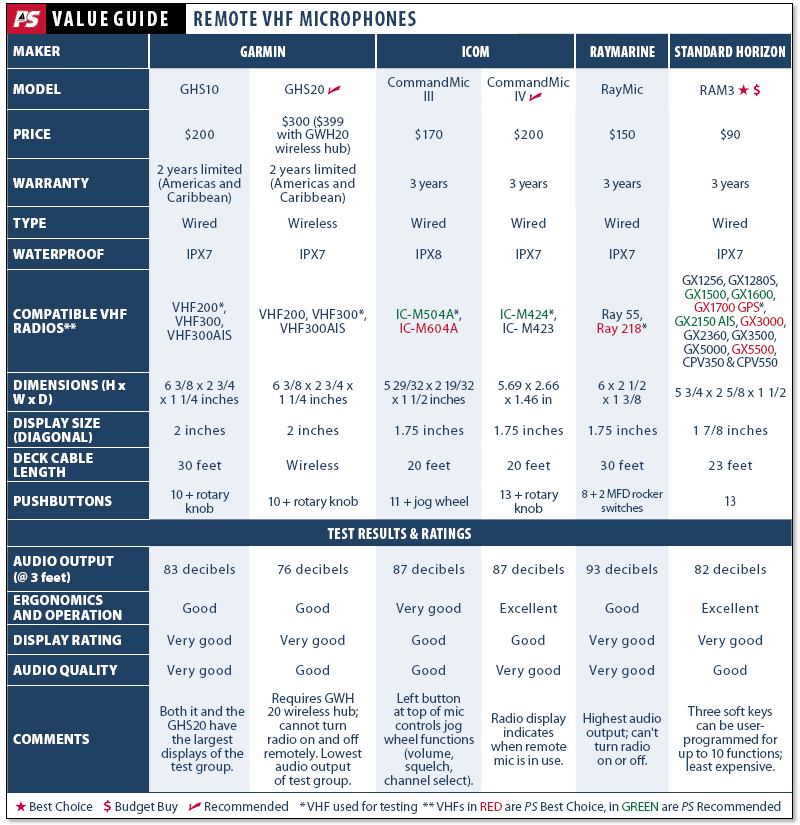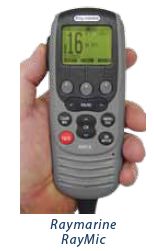
381
Remote microphones for fixed VHF radios are great tools for both coastal and bluewater sailors, but they can be essential for short-handed crews. Remote mics allow the VHF transceiver to be mounted belowdecks—where the radio operator can safely make clear communications in heavy weather—yet they offer full-radio function at the helm, for times when leaving the tiller isn’t an option.
Remote mics provide a helm station with greater power, range, and talk-time than a handheld VHF; however, they do not offer the redundancy of a second fixed VHF or limited-range handheld.
When considering a remote mic, your choices are determined by whether or not you already own a VHF. If you do, and you’re not ready to upgrade, then you’re stuck with the options that are compatible with your existing VHF. But if you’re shopping for the whole kit-and-kaboodle, then it’s important to first compare fixed VHFs and then remote mics, as they are merely accessories. Once you’ve narrowed your list of VHF candidates, you can weigh the pros and cons of the different mics available.
PS reviewed budget marine VHFs in the June 2012 issue and high-end fixed VHFs in the July 2012 issue. We highly recommend reading both articles to supplement this review of remote mics.
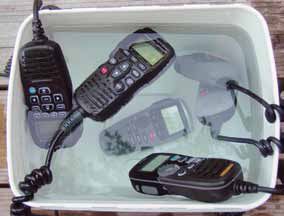
284
What We Tested
During our last look at remote mics in the November 2007 issue, Icom’s CommandMic III took Best Choice honors, while both the Standard Horizon VHF310 and Raymarine’s RayMic garnered Recommended ratings. For this remote mic test, we rounded up six units, each designed to work with two or more compatible, fixed-mount marine VHF radios. Five of the six test mics are hard-wired to their host radio, and one uses wireless technology.
Icom, a global company whose product line includes communications equipment and products for the marine, avionics, and wideband receiver industries, provided two units: the 2007 Best Choice CommandMic III and the CommandMic IV. From Raymarine, a subsidiary of FLIR and a world leader in marine electronics for recreational boating, we tested a new RayMic, and from electronics icon Standard Horizon, we tested the RAM3 mic. Garmin, a worldwide provider of navigation, communication, and information devices, was represented in the test by its wired GHS10 and wireless GHS20 microphones.
Similar in size and weight, the plastic test mics range in price from $90-$400 (including required hardware). They all have full dot-matrix LCD displays, similar controls (buttons, knobs, dials, etc.), and provide full control of the mated VHF (so, for example, if the paired radio has a hailer or fog signal, you can use or initiate it from the remote). These features are described in more detail in our June and July 2012 reports on VHFs.
The extension cables of the five wired mics all have two wires for connecting the mics to external passive speakers.
All of the test mics are waterproof. The Icom CommandMic III was the only one rated as IPX8, which means it can withstand continuous immersion. The others are rated IPX7, able to withstand immersion to 3 feet for 30 minutes.
The test handsets all feature a covered, well-marked Digital Selective Calling (DSC) distress calling button, and they can control the DSC functions their mated radio offers. For example, the RayMic allows users to make individual, group, and all ships calls remotely when it’s paired with the Best Choice Raymarine 218 VHF, which has the same DSC capabilities.
Testers found it odd, and inconvenient, that two of the test mics, Garmin’s GHS20 and Raymarine’s RayMic, were designed without the ability to turn on/off the host VHF. All of the mics, except the battery-powered GHS20, are powered through their mated VHFs and draw less than an amp at maximum volume.
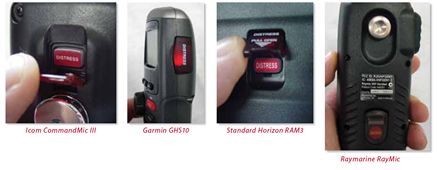
437
How We Tested
Power was supplied to each hardwired microphone through its accompanying radio via a single cable. All host radios were supplied with 13.8 volts DC provided by a regulated power supply, and the wireless GHS20 had its battery fully charged prior to testing.
Each test microphone was run through a laundry list of operations. The more capabilities a microphone possessed, the higher it was rated. Criteria for higher ratings in functionality included the ability to control every function on the host radio and the ease of operation (intuitive controls, one-handed operation, ergonomics, etc.).
Microphone display screens were rated based on readability, the amount and quality of data shown, and the lighting. Larger screens displaying lots of data received the highest ratings.
To rate the audio systems, we measured sound pressure levels at maximum volume while inputting a 1-kHz tone. Sound levels were measured from 3 feet away. Testers also monitored a weather channel at various volumes to determine overall sound quality.
Each microphone was immersed in 1 foot of fresh water for 30 minutes to confirm it was waterproof. We then tested them for proper operation immediately after the dunking and again 24 hours later.

209
Garmin GHS10
The GHS10 mic, which provides full radio control of Garmin’s VHF200 or VHF300/300 AIS radios, features a 2-inch LCD display, matching the GHS20 for the largest screen in the test field. The GHS10 has dedicated rotary and push buttons for common tasks, and three soft buttons for dynamic controls. All buttons and knobs are similar to those on the host radio. In addition to being able to be connected to an external speaker, the GHS10 has intercom capabilities when connected to an appropriate speaker.
Testers did note one negative: Adjusting volume, a very common task, requires multiple steps. The user must push the VOL/SQL button twice, then adjust volume using the rotary knob. This is not ideal, in our opinion.
Testers rated the GHS10 display Very Good. Data was easily discernible, and the channel numbers were among the largest of the group, matched only by those of the GHS20 and RayMic. Audio quality was also rated Very Good.
The $200 GHS10 comes with a two-year limited warranty that is valid in the Americas and the Caribbean.
Bottom line: The GHS10 is a well-built mic that offers complete control of the mated radio, but its shorter, limited warranty is a concern.
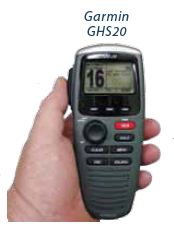
Garmin GHS20
The only wireless microphone in our test, the GHS20 can be mated with Garmin’s VHF200, VHF300, and VHF300 AIS series radios, although some radios may require a software update before being compatible.
The GHS20 is physically the same as the GHS10, but it has full wireless capability. Function-wise, the only difference is that the GHS20 cannot turn the host radio on and off and the GHS20 requires a GWH20 wireless hub to interface with the host VHF. The hub can be bought separately ($150) or as part of a bundle with the $300 GHS20 for an added $99. Each GWH20 provides intercom capability with the VHF and can support up to three mic handsets.
Setting up the GHS20 with the radio was simple and straightforward.
The convenience of being able to transmit over VHF from anywhere on board using the GHS20 is unmatched by the wired mics we tested. However, having a handset that is battery powered has its down sides, including a finite run time and battery replacement costs. The GHS20 uses a rechargeable lithium-ion battery that charges when the handset is in its provided cradle. An LED light on the mic face shows charging status and provides basic troubleshooting indications (battery over temp, defective battery, etc.), and an icon showing charge status is displayed on the mic screen.
According to the owner’s manual, a fully charged battery provides 18 hours of operation and recharging can take up to four hours. To test this, we charged the battery overnight and then set the mic to a weather channel, leaving it on at low volume. Fully charged, the battery lasted for 17.5 hours. The maker claims the battery’s life expectancy is 100 charge cycles at 90-percent capacity, or 500 cycles at 75-percent capacity. The battery is not user-serviceable, so when it dies, you have to ship the mic off to Garmin to have it replaced. If this happens after the two-year warranty period, the service will cost you $120.
The GHS20’s battery life far exceeded that of the last wireless mic we tested, the Uniden WHAMx4 (PS, November 2007). The WHAMx4’s nickel metal hydride battery last a mere two hours after a 14-hour charge.
To test the effectiveness of the GHS20’s wireless link, we monitored incoming voice transmissions while gradually moving away from the host radio. Reception was very good for an unobstructed distance of about 125 feet—a pleasant surprise to testers—but we experienced a gradual increase in static past that point. Reception between the mic and the VHF through two walls at our test facility was excellent.
The GHS20 does not float, and while Garmin supplies a wrist lanyard and belt clip for it, we would prefer that the mic float or that it have a lanyard with an integral float (like those often used on waterproof cameras). For installations where the mic’s charging cradle is belowdecks, we suggest an additional mount in the cockpit, so there’s always a dedicated place to find it. Garmin sells these for about $2.
Testers rated the GHS20 display as Very Good and audio quality as Good, but volume was rated the lowest of the test group. The GHS20 performed well and the wireless connection eases installation headaches, but at $400 for the mic and required wireless hub, it’s the most expensive unit of our test group—even without accounting for the potential $120 battery replacement cost.
The GHS20’s limited warranty is valid only in the Americas and Caribbean.
Bottom line: Held back only by limited warranty and cost, the GHS20 is a top performer and carries the added wireless conveniences of easy installation and more mobility. It gets our recommendation for those seeking a wireless remote mic.
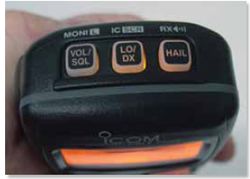
250
Icom CommandMic III
The CommandMic III is designed to provide full functionality of Icom’s IC-M504A (Recommended VHF, July 2012) and IC-M604A (Best Choice VHF, July 2012). It features a multi-function rotary dial that provides quick access to settings like channel selection, AF volume, squelch, and menus. Testers found that the front panel dial on the CommandMic III made the most common tasks—adjusting volume, squelch, and channels—super easy.
Pushbuttons located on the front panel control channel selection, quick 16, scan, and menu functions. On top of the mic are three buttons that also select volume, squelch, channel, distant or local reception, intercom, and hail. Push-to-talk and high/low power buttons are mounted on the mic’s side.
The CommandMic III’s screen was in the middle of the pack for size, but testers found it easy to read and rated it Good overall. Audio output and quality also were rated Good. The mic appeared to be well constructed, and controls were intuitive to operate, although testers found the buttons on the mic top to be a bit awkward in use and not very conducive to one-handed operation.
The CommandMic III has the only IPX8 waterproof rating of the group. Both CommandMics come with three-year warranties.
Bottom line: A solid performer with an easy-to-use jog dial, the 2007 Best Choice CommandMic III was eclipsed in this test by its younger sibling, the CommandMic IV. However, we still find the III to be a quality product, and it is a great choice for owners of the IC-M504A and IC-M604A VHFs.

272
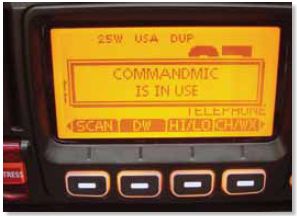
Icom CommandMic IV
Icom’s latest remote VHF option, the CommandMic IV, has the same soft-key user-interface as its compatible VHFs, the fixed Icom IC-M424 (PS, July 2012) and the handheld Icom IC-M92D, which we’re currently testing.
Icom designed the soft-key interface to be easier and faster to use—with fewer button pushes— than a menu-driven interface. Testers gave it two thumbs-up, noting that the interface was very intuitive. They also liked the mic’s “in hand” feel and the buttons’ ergonomic layout.
It was the only unit tested that indicated when the remote mic was in use by showing a message on the host radio’s display, a feature testers liked.
Although the rotary volume/squelch knob was located at the top of the mic, it was easy to access and operate, primarily because it offered more relief than the CommandMic III’s flush-mounted top buttons, which require the user to tilt the mic forward to see what they are doing.
Testers rated the CommandMic IV’s display Good, but its channel numbers were the smallest of the test group. Audio quality earned a Very Good rating.
Bottom line: Good performance coupled with innovative software, user-friendly operation, and a three-year warranty make the CommandMic IV a great choice. It gets PS’s Recommendation.

154
Raymarine RayMic
The RayMic provides full remote control of the Raymarine Ray55 and Ray218 VHF radios. Its pushbuttons are all located on the mic face, the same place as those of the Ray218. The only exceptions are the push-to-talk, which is located on the mic side; the DSC distress button, which is on the back; and hailer control, which is handled through a menu.
The RayMic has all the usual controls one would expect—volume, channel selection, squelch, intercom, quick 16, and scan—but it does not allow users to power on/off the mated VHF.
Three soft keys just below the screen offer easy access to menus and instant selection of three preset channels. (Up to three favorite channel groups can be stored in memory.) DSC calling is controlled through a menu.
Just as the mic pushbuttons mirror the VHF’s buttons, the handset screen is identical to the radio’s display. It shows large, easy-to-read channel numbers with comments scrolling below, and all the same icons for transmit, receive, transmitter power output, and the channel group selected.
Testers rated the mic’s display and overall ergonomics Very Good. The RayMic had the loudest audio output of the test group, but the sound was a bit distorted at maximum volume.
The RayMic comes with a 30-foot control cable. If you need more cable length, Raymarine recommends using a maximum of two, 30-foot-long cables connected in series.
The RayMic, a Recommended product in our 2007 test, comes with a three-year parts and labor warranty.
Bottom line: A top performer, the RayMic is a good choice for those with Raymarine VHFs, including the Ray218, our Best Choice among high-end VHFs (PS, July 2012). In a tight comparison with fairly equal competitors, the RayMic was held back by its inability to turn on the host VHF.

381
0)]
Standard Horizon RAM3
Standard Horizon’s RAM3 remote microphone provides full remote control of its Quantum, Matrix, Quest-X, Quest+, and Phantom series fixed VHF radios. This also includes intercom function between the mic and connected radio, as well as between two RAM3 mics (Matrix and Quantum models). Additional features include a mic speaker with Standard Horizon’s Noise Canceling Clear Voice Technology, three user-programmable soft keys, and backward compatibility to RAM+ (CMP25).
When connected to the Matrix GX3000S or the Quantum Series VHF, the RAM3 also controls the 30-watt PA and hailer functions. Its mounting spot can be up to 70 feet from the host radio using two of the optional 23-foot extension cables.
Audio quality for the RAM3 was rated Good, while the display was rated Very Good, as were the overall ergonomics of the mic. In addition to large and easy to read channel numbers, testers noted that it was comfortable to hold and that the locations of controls and buttons were convenient and made operation simple. Testers also liked being able to configure the mic’s three soft keys, which can be user-programmed for up to 10 functions that can be displayed in a user-prioritized order.
The RAM3 remote mic costs $90 and carries a full, waterproof three-year warranty.
Bottom line: The RAM3 is a highly rated, full-function mic that works with nearly every fixed-mount VHF in Standard Horizon’s current lineup—including several of our Best Choice radios. The least expensive of the bunch, it secured our Budget Buy and Best Choice picks.
Conclusions
While a boat owner wishing to add a remote mic to an existing VHF is limited to mics offered by the radio’s manufacturer, those owners not yet committed can compare the pros and cons of the entire test group to help with both mic and radio purchasing decisions.
There was no Super Mic in this test field. All were on pretty equal footing, performance wise, so testers had to get down to the nitty-gritty details in choosing top picks. In the end, Best Choice and Budget Buy went to the best-priced Standard Horizon RAM3, followed very closely by the highly Recommended CommandMic IV. The GHS20 gets our recommendation for the wireless niche, though we’d prefer that it float and have a user-serviceable battery.
If you’re shopping for a mic and a fixed VHF, consider the RAM3 mated with one of several Recommended Standard Horizon VHFs (PS, June and July 2012), including the AIS-equipped Matrix GX2150, the affordable GX1600, or the GPS-equipped Explorer GX1700 VHF, which was the Best Choice among mid-priced VHFs. If you purchase a GX1700, be sure to confirm with the retailer that is has the latest firmware. (See “Product Update” in Mailport for more on this.)
The RayMic would serve well paired with the Ray218 VHF, our most recent Best Choice among high-end radios, and a good Icom package would be the CommandMic IV with the IC-M422, which testers recommended among high-end VHFs. For those who must have a wireless mic, check out the GHS20 with the Garmin VHF 300, a solid performer in our last test.
